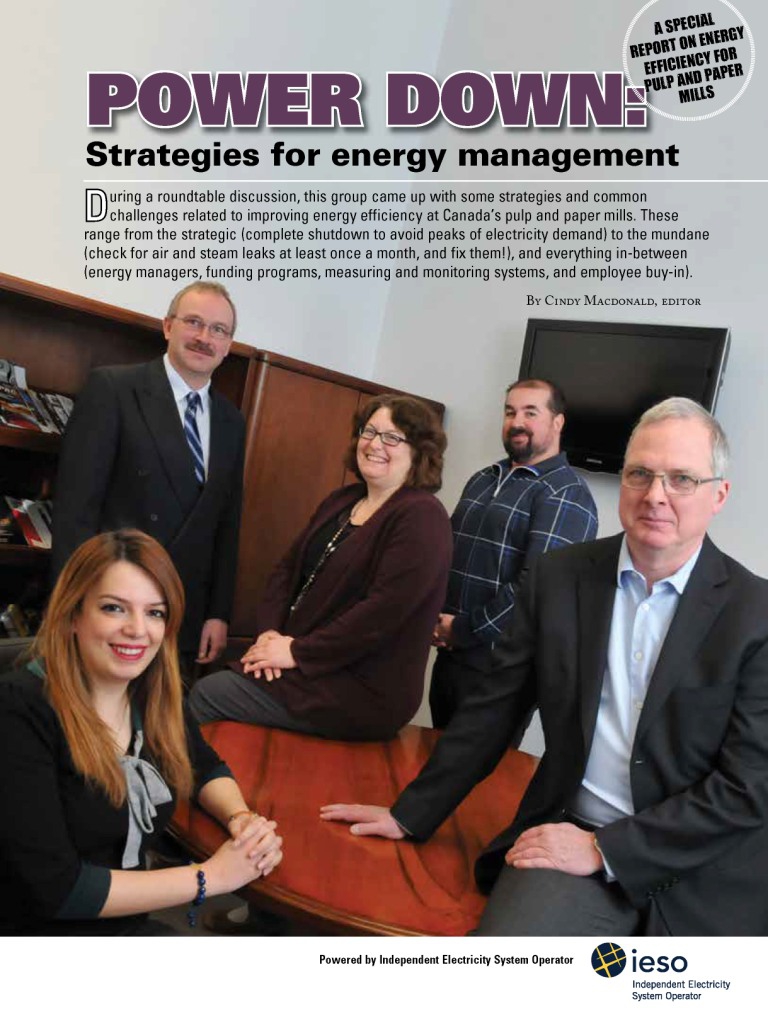
Features
Energy Management
Power down: Strategies for energy conservation
April 15, 2016 By Cindy Macdonald
 To get a better understanding of how the industry is addressing the challenges of energy conservation
To get a better understanding of how the industry is addressing the challenges of energy conservation A special report on energy efficiency for pulp and paper mills
Managing power consumption has become a complex game of strategy for pulp and paper mills in Canada, with high stakes. The advent of time-of-day pricing, peak mitigation programs and deregulated electricity markets in various jurisdictions across the country means large energy users have to be constantly aware of their electricity usage, and constantly weighing the costs vs. the benefits.
At pulp and paper mills in Alberta, operators in the control room monitor electricity pricing on a continuous basis, and shut down production when the cost becomes prohibitive. Similarly, in Nova Scotia, one integrated mill does its energy-intensive pulping at night, and shuts that process down during the day.
It’s not an easy thing to shut down a process that produces paper or board at a rate of about 1000 m/min.
In concert with these drastic measures, pulp and paper companies are implementing smaller energy conservation measures throughout their plants to bring electrical consumption down.
To get a better understanding of how the industry is addressing the challenges of energy conservation, Pulp & Paper Canada hosted a round table discussion, made possible by Ontario’s Independent Electricity System Operator (IESO). That discussion forms the basis for this special report. The panelists consisted of operations personnel, energy managers, one machinery supplier and one technical specialist. They brought a wide range of experience and expertise to the table.
Here’s a glimpse of some of the topics covered in Power Down: Strategies for Energy Conservation.
Read the full report here.
Cultivate a culture of awareness
In the industrial environment of a pulp and paper mill, achieving energy efficiency gains requires the engagement of both people and technology. An energy efficient producer must create a culture that takes action, and employees must understand technology and use it to minimize consumption of resources – electricity, air, water, heat.
Tom Browne, as a research leader with the national research and innovation organization FPInnovations, has vast experience with process optimization at mills. “The most efficient mills are not necessarily the newest ones,” he observes. “It has to with the employees and the management style.”
Audits lead to savings
Sometimes, it simply takes a fresh set of eyes to identify energy saving opportunities and initiate changes. The impetus to take action can come from something as simple as questions from a visiting technical service representative, or from a mill-wide audit by an external consultant.
A recent poll conducted among readers of the Annex-Newcom network of business-to-business publications found that only 38 per cent of respondents reported that their company had conducted an energy audit in the past five years.
Among those whose companies did conduct an energy audit, nearly half (43 per cent) reported that the audit was conducted by an “energy consultant or certified auditor.”
Conservation needs an advocate
Having an energy manager on-site is another important tool for building energy efficiency. In some parts of the country, there are programs that subsidize the salary of an energy manager. “Personally, I have been responsible for 7900 hours of megawatt reductions in the last three years, which translates to 45 projects,” says Adam Muree, and energy manager with Atlantic Packaging.
An energy manager acts as an advocate, keeping energy savings on the front burner when executives in other areas of the company have other priorities.
Click here to read the full report.
Print this page